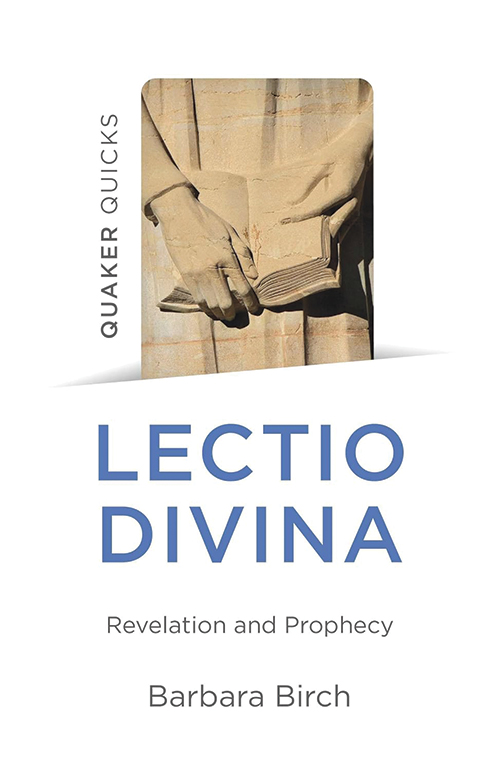
Lectio Divina: Revelation and Prophecy
Reviewed by Bob Dixon-Kolar
October 1, 2025
By Barbara Birch. Christian Alternative Books (Quaker Quicks), 2025. 112 pages. $12.95/paperback; $4.99/eBook.
Lectio divina, Latin for “divine reading,” is a contemplative practice that for centuries has played a spiritually transformative role for monastic Catholics. Trappist monk Thomas Merton once described lectio divina and its place in the lives of those committed to a monastic vocation: “It is understood that the personal prayer of the monk is embedded in a life of psalmody, liturgical celebration and the meditative reading of Scripture (lectio divina). All this has both a personal and a communal dimension.”
In her stimulating book Lectio Divina: Revelation and Prophecy, Barbara Birch shows how Friends can adapt this contemplative practice to enrich their solitary prayer as well as their corporate worship among Friends. When grounded in silence and receptivity, lectio divina can bear fruit in continual divine revelation and in prophetic ministry that contributes—through consolation, encouragement, or exhortation—to the sense of vitality and unity that marks a gathered meeting.
Lectio divina was formalized as a process by a twelfth-century French Carthusian monk named Guigo II. Birch explains: “He laid out four steps of ascending awareness of the Divine: lectio (reading), meditatio (thinking about), oratio (praying), and contemplatio (internal stillness and awareness of the presence of God).” In her own practice, Birch applies lectio divina to a variety of sacred or inspirational writings.
She tells how she took up an essay from Quaker Thomas Kelly and “tried reading in an embodied and devotional way.” Birch surrenders herself to the bodily, tactile aspects of prayerful reading. She moved slowly through Kelly’s text with an earnest intent to understand: plumbing its meanings, exploring etymologies, voicing phrases and lines in her head and out loud, noting their rhythm and tones, chanting their more musical elements, and gesturing with her hands to follow along with the words’ pulse and flow. In time, the text became part of her, an indwelling presence. She would also write out select passages by hand with a fountain pen—ink splatters and all!—further reinforcing her felt connection with the shapes and sense of the words and with her hand, heart, and mind.
She explores the latter stages of lectio divina:
When I processed meanings in my own words, I made mind/heart associations recollected from the past. This is meditatio. Sometimes the words trailed off after a kind of wakeful opening, which I wrote about afterwards. This is what ancient monks and nuns called contemplatio. Meditatio and contemplatio seem intimidating, and yet, my insights were not earthshattering even though they were helpful to me.
An instance of contemplatio that Birch recorded after abiding with one of Kelly’s insights reveals what she calls “some deeply ambivalent and thought-provoking feelings.” She writes:
serenity, unshakeableness, firmness of life-orientation—what does this mean in the face of clear signs of going the wrong way? I’m not an established woman, very far from it. Loss, humiliation, disappointment are the results of vulnerability this time. Accept. . . .
This contemplatio shows that opening oneself to continual revelation demands a willingness to self-question; to search beyond the comfortable; indeed, to see through new conceptual and spiritual lenses. This revisioning can feel unwelcome, even painful. At the same time, it aids our personal growth; it helps us turn more fully toward the Divine.
In the author bio, Birch is described as “a white cisgendered middle class woman baby boomer trained as an academic in the field of applied linguistics.” This is the lens most familiar to her. Yet to read her book is to realize—and appreciate—that Birch rejects treating any single lens as the final revelation of all that is to be known about life and the sacred. She urges Friends to look from fresh perspectives: flexibly, generously, with a sympathetic imagination. “Let’s imagine switching lenses,” she suggests, “like an eye doctor flips through different lenses to test our vision and fit glasses for our eyes. The new lenses are feminism, womanism, Black theology, and Queer theology.”
For many, myself included, what Birch enjoins would require us to examine our prejudices; to reframe our constricting mindsets; and, in short, to submit ourselves to change. Her Quaker theology is inclusive: “To me, the Divine is a cosmic and incarnate noninterventionist force of being, Presence, Satyagraha, Love, or Oneness.” Not every Friend would characterize divinity in these universalist terms. Most Friends, however, who choose to read Birch’s Lectio Divina will profit greatly from the experience.
Bob Dixon-Kolar is an emeritus professor of English. He and his family are members of Evanston (Ill.) Meeting.



Comments on Friendsjournal.org may be used in the Forum of the print magazine and may be edited for length and clarity.